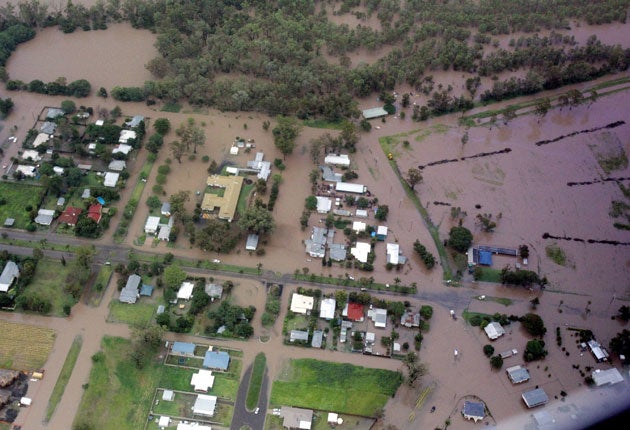'Biblical' floods displace 200,000 Queenslanders
Area the size of France and Germany combined is swamped after days of torrential rainfall

The worst floods in Queensland's history, described yesterday as "a disaster of biblical proportions", have swamped an area the size of France and Germany combined and displaced more than 200,000 people.
With 22 towns inundated following Australia's wettest spring on record, many Queenslanders endured a miserable start to the new year. The next few days are forecast to be no better, with swollen rivers expected to rise still further before starting to subside later this week. As the Queen sent "sincere sympathies" to those affected, the state government began counting the cost, which will include not only a massive clean-up bill, but also lost farming, mining and tourism income.
A giant inland sea, peppered with islands of dry land crowded with stranded livestock, stretches across Queensland. Yesterday small boats and helicopters ferried people and emergency supplies around. In the tropical north of the state, authorities warned that the rains – which have inundated coal mines and cut major highways – might have washed crocodiles and poisonous snakes into flooded homes.
For families living in evacuation centres, unable even to return home to assess the damage, the situation could hardly be more depressing. The Prime Minister, Julia Gillard, who announced a disaster relief fund after touring the flood-stricken town of Bundaberg, said yesterday that the crisis was still far from over.
The floods, caused by six river systems breaking their banks following torrential rains, are a reminder of the extremes of the Australian climate. An end to the prolonged drought was announced in Queensland only a fortnight ago; now farmers are contemplating vast acres of ruined crops. In Victoria and South Australia, meanwhile, searing temperatures have triggered major bushfire alerts.
In Queensland, the flood-ravaged towns include Theodore, where the entire 300-strong population has been evacuated and the Dawson river – already at 49 feet – has yet to peak. With the floodwaters making their way towards the sea, the coastal city of Rockhampton – home to nearly 77,000 people – was cut off yesterday, with roads flooded and the airport closed to commercial flights.
Residents were evacuated from low-lying areas, and the Rockhampton mayor, Brad Carter, warned that 40 per cent of the city could be affected by the time the Dawson peaks on Wednesday. He said people who refused to leave their homes would be forcibly removed, for their own safety. He also predicted that the airport might have to remain shut for up to three weeks.
In the central Queensland town of Emerald, 80 per cent of which was submerged last week, the picture was slightly more cheering yesterday, with a limited number of people expected to be allowed home after the Nogoa river receded slightly. Aerial shots show that at least 1,000 properties have been flooded, while another 3,000 have been damaged. The mayor, Peter Maguire, said it could be months before life returned to normal.
The Department of Community Safety said supplies of food and bedding were delivered by road and by military aircraft on Friday to the towns of Rockhampton, Emerald, Springsure and Blackwater in Central Queensland.
The waters have also retreated in the sugar town of Bundaberg, where authorities have begun cleaning up. But other communities – such as Condamine, in the Darling Downs region – could remain abandoned for another week.
"In many ways, it is a disaster of biblical proportions," Andrew Fraser, the state's treasurer, told Australian Broadcasting Corporation radio. "The list of towns affected is a long one. The cost to the state will be huge – both in direct costs, such as rebuilding roads and other damaged infrastructure, and providing relief payments to families, but also in lost income while the mining, agriculture and tourism sectors recover."
Anna Bligh, the premier of Queensland, has said the recovery will cost "literally billions of dollars".
Four Army Blackhawk helicopters and a Chinook were on standby yesterday to make food drops to isolated properties.
The Queen said she had been following news of the floods "with great concern", and sent her sympathies to "all the people whose communities and livelihoods have been so badly damaged".
Join our commenting forum
Join thought-provoking conversations, follow other Independent readers and see their replies
Comments